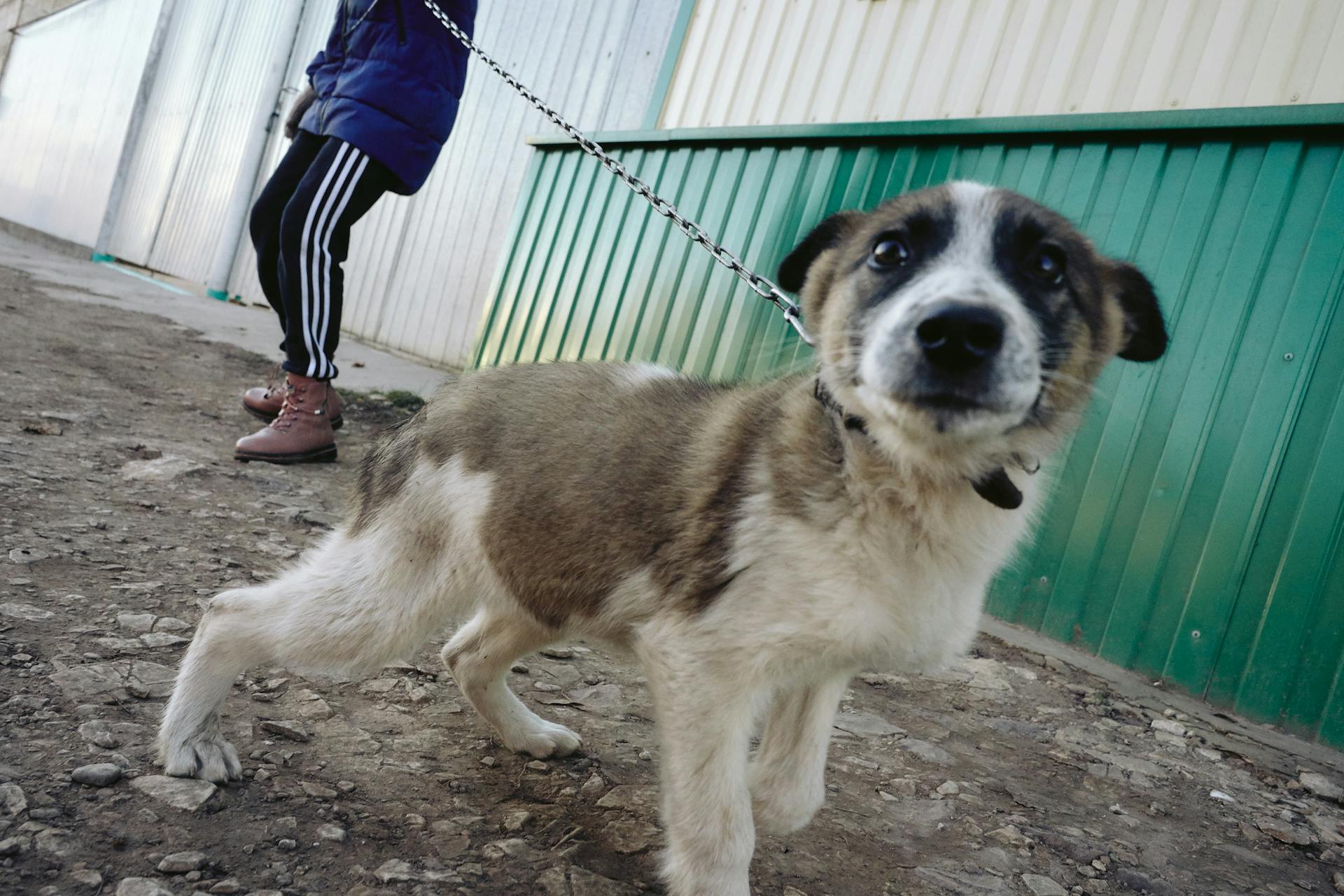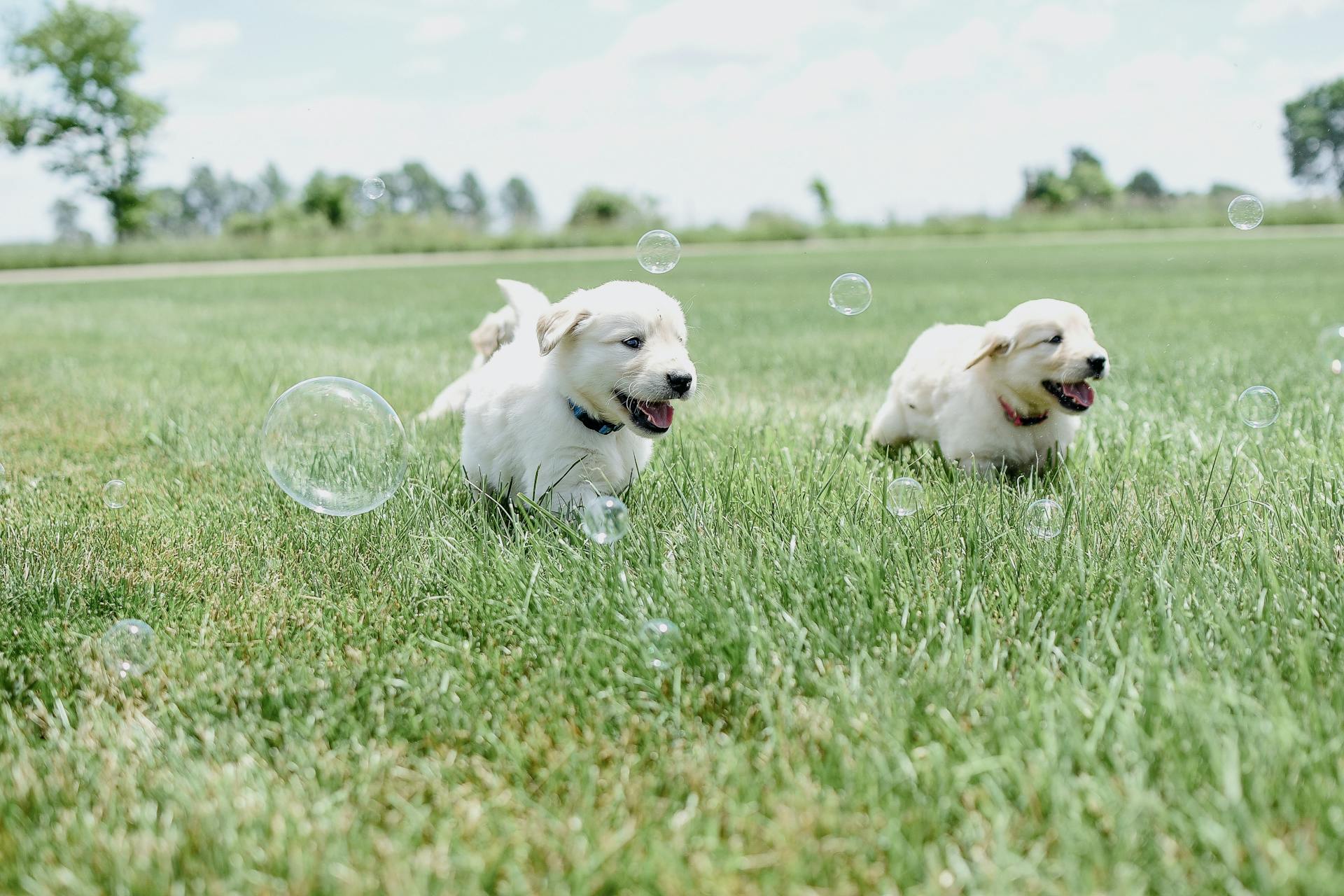
Aussiedoodles can be a handful, especially if you're new to dog ownership or haven't had experience with high-energy breeds. They require a lot of exercise and mental stimulation to prevent boredom and destructive behavior.
One common behavior problem in Aussiedoodles is separation anxiety, which can lead to excessive barking, howling, and even destructive behavior when left alone. This is often a result of their strong attachment to their family members.
If you're not providing enough physical and mental stimulation, your Aussiedoodle may resort to digging, chewing, or escaping from the yard. This is a sign that they need more exercise and attention.
Aussiedoodles are intelligent and trainable, but they can be stubborn at times, making consistency and positive reinforcement essential for good behavior.
Exercise and Stimulation
The Mini Aussiedoodle needs plenty of exercise each day to stay happy and healthy. This means at least one hour of physical activity, such as walks, jogs, or hikes, to keep them active and engaged.
If you don't give your Mini Aussiedoodle enough exercise, they may become prone to stress, anxiety, depression, and destructive behaviors. Consistent and routine exercise is a must for this breed.
Without proper exercise, your Mini Aussiedoodle may resort to chewing on furniture or other objects around the house. This is because they have too much pent-up energy and need healthy outlets for it.
Mental stimulation is also crucial for the Mini Aussiedoodle, as they can become destructive if they get bored. Engaging toys and a regular exercise schedule can help reduce anxiety and problematic behaviors.
You might enjoy: Do French Bulldogs Have Separation Anxiety
Bored Pets Can Be Destructive
Bored pets can be destructive, and it's especially true for Mini Aussiedoodles. They require plenty of exercise and mental stimulation to prevent boredom and destructive behaviors.
If your Mini Aussiedoodle is left to become bored during the day, he may resort to chewing on furniture or other objects around the house. This is because they are so clever and need to be kept engaged.
Mental stimulation is incredibly important for Mini Aussiedoodles, as it can help reduce anxiety that can lead to health issues and problematic behaviors. Puzzle toys are a great way to provide mental stimulation, keeping your dog occupied and thinking about how to solve the puzzle.
Regular exercise is also essential to prevent boredom and destructive behaviors. A daily outdoor time is necessary for your Mini Aussiedoodle to run around and get his exercise fix.
Here are some tips to prevent boredom and destructive behaviors in your Mini Aussiedoodle:
- Provide plenty of engaging toys and puzzle toys to keep your dog stimulated.
- Keep your dog on a regular exercise schedule, including daily outdoor time.
- Consider investing in puzzle toys that will keep your dog occupied and thinking.
By following these tips, you can help prevent boredom and destructive behaviors in your Mini Aussiedoodle and keep him happy and healthy.
Prey Drive
Prey Drive is a natural instinct in many dogs, including Doodle breeds. It's a strong desire to hunt and chase smaller animals like squirrels, rabbits, and even cats.
Mini Aussiedoodles may exhibit prey drive due to their parent breeds' herding and hunting instincts. They might chase smaller animals when outside, which can be problematic if not managed.
Consistent training can help alleviate prey drive behaviors, but it's essential to work with your dog early on to establish a strong recall. This will help prevent them from chasing after smaller animals.
Walking your Mini Aussiedoodle on a leash and harness is crucial to keep them safe and prevent them from chasing into busy streets. Even with training, they may still have an uncontrollable urge to hunt and chase smaller animals.
Prey drive is one of the most common Doodle behavior issues, and Aussiedoodles tend to rate lower in this area due to their herding instincts.
You might enjoy: Behaviorist Dog Training
Intensity/Hyperness
Goldendoodles and Labradoodles are generally laidback breeds, with a tendency to be more relaxed and less intense.
Their intensity levels are rated mostly Very Good, meaning they're less likely to pull hard on the leash or jump on people.
However, Bernedoodles and Aussiedoodles are noticeably intense and hyper, with intensity levels rated mostly Satisfactory.
This difference in intensity can be a consideration when choosing a breed or understanding their exercise needs.
Goldendoodles and Labradoodles seem to require less stimulation and exercise to stay happy and healthy, while Bernedoodles and Aussiedoodles may need more to burn off their excess energy.
Their varying intensity levels can also affect how they respond to training and socialization.
Mini Aussiedoodle Behavior
Mini Aussiedoodles may chase smaller animals like squirrels or rabbits when outside, which can be problematic if you don't want them barking at your children and nipping at their heels as they run around the house.
Consistent training can help alleviate these behaviors, but it's also essential to work with youngsters on how to respectfully behave around their furry family member.
To prevent chasing smaller animals, it's best to walk your Mini Aussiedoodle on a leash and harness, especially in busy streets.
A solid recall is crucial for Mini Aussiedoodles, and early training can help ensure they respond promptly to their name.
Here are some key takeaways for managing Mini Aussiedoodle behavior:
- Consistent training is essential to alleviate herding or hunting instincts.
- Work with youngsters on how to respectfully interact with their furry family member.
- Walk your Mini Aussiedoodle on a leash and harness to prevent chasing smaller animals.
Mini Aussiedoodles' Instincts
Mini Aussiedoodles may chase smaller animals like squirrels or rabbits when outside, which can be problematic if you don't want your dog barking at your children.
Herding Instincts Can Be a Problem
Mini Aussiedoodles may also have herding instincts, which means they could try to herd people, especially very small children. This can be a challenge to manage, especially if you have young kids who like to run around the house.
Consistent Training is Key
Consistent training can help alleviate these behaviors, so it's essential to work with your Mini Aussiedoodle early on to ensure he has a solid recall.
Safety First
It's also crucial to walk your Mini Aussiedoodle on a leash and harness when outside to keep him safe from busy streets and smaller animals.
Mouthiness is a Possibility
Mini Aussiedoodles may also be prone to mouthiness, which can lead to damaged furniture, shoes, and other household items if not addressed early on.
You might like: Dog Training Issues
Understanding Labradoodles
Labradoodles are known for being intelligent and friendly, but their intelligence means they can get bored easily if left alone too long or not given enough mental stimulation.

They're usually pretty easy to train because of their smarts, but it's essential to provide them with proper training from puppyhood onwards to avoid destructive behavior.
Labradoodles are social creatures that don't like being left on their own for long periods, which can lead to separation anxiety. Some signs of separation anxiety include excessive barking or howling when you're away and destructive behavior around the house.
Resource guarding is another common issue in Labradoodles, where they become possessive over toys or food bowls. This isn't necessarily aggressive behavior, but it's something you need to address early before it becomes a problem.
Consistency and patience are key when training a Labradoodle. If you're telling them 'no' today but 'yes' tomorrow for the same action, they'll definitely end up confused. So make sure everyone in the family understands and follows the same rules.
Here are some common behaviors in Labradoodles and how to manage them:
- Chewing on furniture: Provide plenty of chew toys and rotate them regularly to keep them interesting.
- Excessive barking: Identify the cause of the barking and address it, such as providing enough exercise or mental stimulation.
- Destructive behavior: Provide plenty of exercise and mental stimulation, and consider crate training to prevent destructive behavior when you're not home.
Remember, every Labradoodle has its unique personality and quirks, and that's what makes them so special. By understanding their behavior and providing them with proper training and care, you can strengthen your bond with your adorable Aussie Labradoodle.
Potential Issues
Mouthiness is a potential issue with Aussiedoodles, with some owners reporting that their dogs are quite mouthy. Aussiedoodles got mixed results in a survey, which could indicate how well the individual dog was trained or the dog's personality.
Labradoodles, on the other hand, were rated mostly as Very Good in terms of mouthiness, but the results are still mixed. This means they are less likely to be mouthy, but it's still possible.
To minimize damage and nip this habit in the bud early on, proper training is key. Providing plenty of chew toys can also help redirect your Aussiedoodle's energy and prevent them from getting into trouble.
Canine Vocalization
Barking and howling are common issues among Doodle breeds, with most rated in the Satisfactory range, meaning they tend to bark more than average.
Barking incessantly is one of the most common Doodle behavior issues, and it's essential to address it early on to prevent problems.
Consider reading: Mini Aussiedoodle Health Issues
Australian Labradoodles, in particular, love to express themselves vocally, which can become problematic if not checked early on. A useful approach is teaching them the 'quiet' command or distracting them with commands they know when they start barking excessively.
Stubbornness can also contribute to excessive barking, as Aussie Labradoodles can sometimes be hard-headed and decide to do things their own way. Consistent training methods with positive reinforcement can help deal with this trait.
Providing plenty of physical and mental stimulation for your dog can also help curb barking and other behavior issues.
Curious to learn more? Check out: Are Labradoodles Aggressive
Food Aggression
Food Aggression is not a common issue among Doodle breeds, with all breeds evaluated as "Excellent" in terms of food aggression. This means they are not prone to growling, biting, or other aggressive behaviors when it comes to food.
However, if your Doodle does exhibit food aggression, it can be a symptom of broader aggression issues. This is why it's essential to address the problem as soon as possible with the help of a certified trainer or animal behavioralist.
In some cases, food aggression can be caused by loneliness and boredom, which can be alleviated by providing your Doodle with enough attention, exercise, and opportunities to socialize.
Issues Solutions

One of the most common issues with Doodles is boredom and loneliness, which can lead to destructive behavior. This is often caused by a lack of attention, exercise, and socialization.
To address this, it's essential to provide your Doodle with plenty of physical and mental stimulation. This can be achieved through regular exercise, interactive toys, and puzzle games.
Consistent socialization is also crucial in helping your Doodle become a well-rounded pup. Expose your dog to different environments, people, and animals to help them develop good behavior.
Reward-based training is another effective solution for addressing behavioral issues. This involves rewarding your dog for good behavior, which motivates them to repeat it.
Here are some key strategies for implementing reward-based training:
- Use positive reinforcement
- Reward good behavior immediately
- Avoid punishment – this might lead to fear or aggression
Separation anxiety is another common issue in Doodles, particularly those that form strong bonds with their human families. If left alone for long periods, they can become anxious and destructive.
To address separation anxiety, try using puzzle toys or leaving the TV on when you leave the house to help keep them entertained.
Some Doodle breeds are more prone to barking than others. In fact, a graph evaluating the Goldendoodle's, Labradoodle's, Bernedoodle's, and Aussiedoodle's tendencies to bark or howl shows that most Doodle breeds tend to bark more than average.
Separation Anxiety
Separation anxiety is a common issue in Aussiedoodles, but it's not as simple as just being anxious when left alone. True separation anxiety is actually not very common, but many dogs may get stressed when their owners leave, especially if they're hyperattached to their owners.
Eliminating in the house, excessive vocalization, chewing and digging, and inability to calm down are all signs of separation anxiety. If your dog is exhibiting these behaviors, it's essential to identify the root cause of the stress.
According to a study, the number one risk factor of separation stress developing is hyperattachment to their owner. To prevent this, start by giving your dog some decompression time when they join a new household. Begin by making sure you're not paying attention to your dog at every moment.
Here are some simple exercises to help your dog become more comfortable being alone:
- Find a place for your dog to relax with a chew treat and sit nearby.
- Completely ignore them to see how your dog does entertaining themselves with a bone.
- If they seem okay, stand up, and if they stop chewing to see what you're doing, take note and sit down.
If your dog seems stressed all day, and is damaging themselves or your home, you'll want to have them evaluated by a veterinary behaviorist. A veterinary behaviorist can dig deeper and create a behavior modification plan and medications to help your dog with their anxieties.
To prevent separation anxiety from growing into a bigger issue, focus on the following:
* Don't make a huge fuss when you leave or come back home.
Training and Management
Consistency is key when training your Aussiedoodle. If you're telling them 'no' today but 'yes' tomorrow for the same action, they'll definitely end up confused!
You need to make sure everyone in the family understands and follows the same rules. Consistency is crucial when training any dog breed.
Patience is everything when dealing with an energetic breed like the Aussiedoodle. Don't expect immediate results - progress takes time!
For more insights, see: How to Train an Aussiedoodle
Positive reinforcement is also a must. Dogs respond well to praise and rewards so always remember to reward good behavior.
Here are some tips to keep in mind:
- Be consistent with training and set clear rules.
- Be patient and don't expect immediate results.
- Use positive reinforcement to encourage good behavior.
If you're finding it hard to manage certain issues despite consistent training attempts at home, don't hesitate to seek help from a professional dog trainer or behaviorist.
Teaching Independence
Teaching your Aussiedoodle to cope with separation is crucial to prevent separation stress from developing. The number one risk factor of separation stress is hyperattachment to their owner.
To prevent hyperattachment, it's essential to give your dog some decompression time when joining a new household. You can do this by not interacting with your dog at every moment, especially when you first bring them home. This may sound easy, but it's surprising how many people like to interact with their new dog constantly.
Start by giving your dog a place to relax with a chew treat and sitting nearby. Completely ignore them to see how your dog does entertaining themselves with a bone. If they seem okay, stand up and see if they stop chewing to see what you're doing.
If your dog seems alarmed when you stand up or walk around, try changing up the chew treat to something that will last at least 5 minutes, like a bone or stuffed toy. You can also make your movements less exaggerated, like standing up halfway and sitting back down.
Here are some tips to keep in mind:
- Use a chew treat that will last at least 5 minutes.
- Make your movements less exaggerated.
Crate training can also help with independence training. However, it's essential to do the exercises while your dog is in their crate, not just when you leave the room. This will help your dog associate the crate with relaxation, not anxiety.
Advanced independence training involves setting up a dog pen with simple obstacles and hiding treats around them. This will encourage your dog to problem solve and search for food without looking to you for guidance.
Leaving Your Dog
Leaving your Aussiedoodle alone can be a challenge, but there are some simple rules to follow to make the transition smoother. Don't make a huge fuss when you leave, as this can spike their adrenaline and make them anxious.
It's normal for dogs to get stressed when their owners leave, but true separation anxiety is relatively rare. Look out for signs like eliminating in the house when they're fully housetrained, excessive vocalization, chewing and digging, and an inability to calm down.
If your dog seems stressed all day, it's essential to get to the root of the problem. Ask yourself if there's a specific reason for their anxiety, like a fear of the garbage truck. A veterinary behaviorist can help you create a behavior modification plan and provide guidance on how to address your dog's anxieties.
Departure cues can be a significant issue for Aussiedoodles. Pay attention to your dog's behavior when you get up and grab your car keys, as this can be a strong predictor of your departure. You can try repeating these actions randomly and repeatedly without leaving to help your dog become desensitized to them.
Some common departure cues to watch out for include pacing when you get dressed or make your morning coffee. To change your dog's view of these tasks, try repeating them randomly and repeatedly without leaving.
Frequently Asked Questions
How do you discipline an Aussiedoodle?
Disciplining an Aussiedoodle effectively involves using positive reinforcement and gentle corrections in the moment, rather than physical punishment or delayed consequences. Learn more about gentle and effective Aussiedoodle training methods
At what age does an Aussiedoodle calm down?
Mini Aussiedoodles typically calm down between 2-3 years of age, but remain an energetic breed throughout their lives. They require consistent exercise and mental stimulation to manage their natural high energy levels.
Sources
- https://embarkvet.com/resources/dog-breeds/aussiedoodle/
- https://yourdogadvisor.com/mini-aussiedoodle/
- https://doodledoods.com/aussiedoodle-bernedoodle-labradoodle-goldendoodle-behavior-issues/
- https://pawsandpup.com/blogs/labradoodle/australian-labradoodle-behavior-problems
- https://www.aussiedoodling.com/post/help-your-dog-cope-with-separation
Featured Images: pexels.com


